brakes VOLVO XC90 2018 Owner´s Manual
[x] Cancel search | Manufacturer: VOLVO, Model Year: 2018, Model line: XC90, Model: VOLVO XC90 2018Pages: 666, PDF Size: 11.32 MB
Page 11 of 666

9
Activating/deactivating Steering assistance during collision risks withoncoming vehicles374
Limitations of steering assistanceduring collision risks from oncomingtraffic 374
Steering assistance during collision risks from behind * 375
Activating/deactivating Steering assistance during collision risks from behind * 376
Limitations of steering assistance during collision risks from behind 376
Symbols and messages for steeringassistance during collision risks 378
Park Assist *
379
Park Assist front, rear and sides 380
Activating/deactivating Park Assist 381
Park Assist limitations 381
Recommended maintenance forPark Assist 382
Park Assist symbols and messages 383
Park Assist Camera *
384
Park Assist Camera views 385
Park Assist Camera trajectory lines 386
Sensor field from Park Assist forPark Assist Camera 388
Starting the Park Assist Camera 389
Park Assist Camera limitations389
Recommended maintenance of the Park Assist Camera 391
Park Assist Camera symbols andmessages 392
Park Assist Pilot *
393
Types of parking with Park Assist Pilot 393
Parking with Park Assist Pilot 394
Leaving a parking space with ParkAssist Pilot 397
Park Assist Pilot * limitations
398
Recommended maintenance forPark Assist Pilot 400
Park Assist Pilot * messages
401
STARTING AND DRIVING
Starting the vehicle
404
Switching off the vehicle 406
Ignition modes 407
Selecting ignition mode 408
Brake functions 408
Brakes 409
Brake Assist System 410
Braking on wet roads 410
Braking on salted roads 411
Maintenance of the brake system 411
Parking brake 411
Activating and deactivating the park- ing brake 412
Settings for automatically activatingthe parking brake 413
Parking on a hill 414
Parking brake malfunction 414
Auto-hold brakes 415
Activating and deactivating Auto-hold at a standstill 416
Hill Start Assist 416
Braking assist after a collision 417
Transmission 417
Gear selector positions for automatictransmissions 418
Page 31 of 666
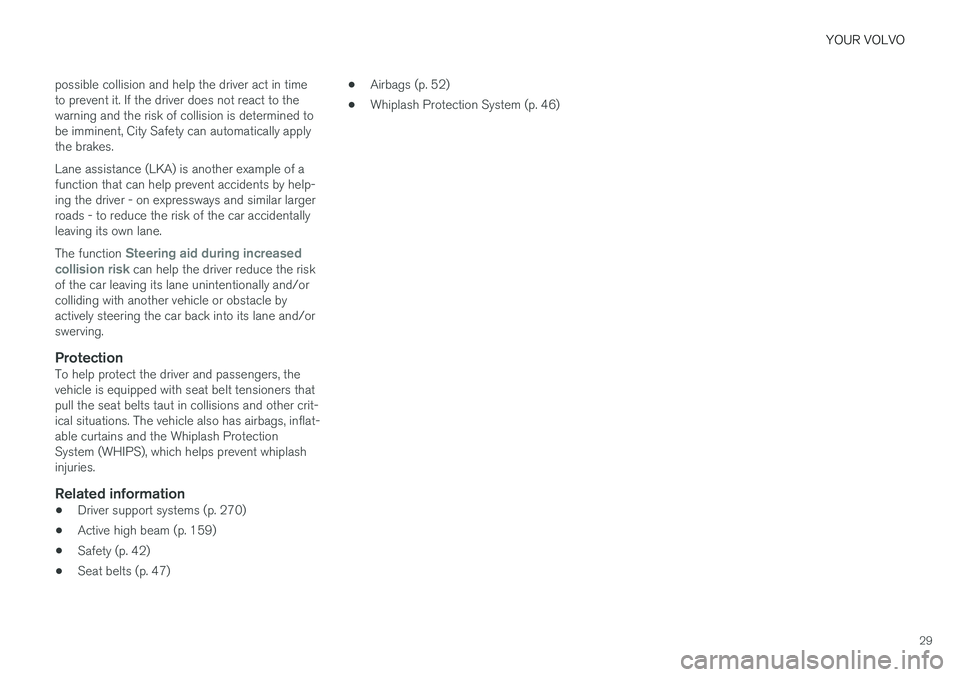
YOUR VOLVO
29
possible collision and help the driver act in time to prevent it. If the driver does not react to thewarning and the risk of collision is determined tobe imminent, City Safety can automatically applythe brakes. Lane assistance (LKA) is another example of a function that can help prevent accidents by help-ing the driver - on expressways and similar largerroads - to reduce the risk of the car accidentallyleaving its own lane. The function
Steering aid during increased
collision risk can help the driver reduce the risk
of the car leaving its lane unintentionally and/or colliding with another vehicle or obstacle byactively steering the car back into its lane and/orswerving.
ProtectionTo help protect the driver and passengers, thevehicle is equipped with seat belt tensioners thatpull the seat belts taut in collisions and other crit-ical situations. The vehicle also has airbags, inflat-able curtains and the Whiplash ProtectionSystem (WHIPS), which helps prevent whiplashinjuries.
Related information
• Driver support systems (p. 270)
• Active high beam (p. 159)
• Safety (p. 42)
• Seat belts (p. 47) •
Airbags (p. 52)
• Whiplash Protection System (p. 46)
Page 52 of 666
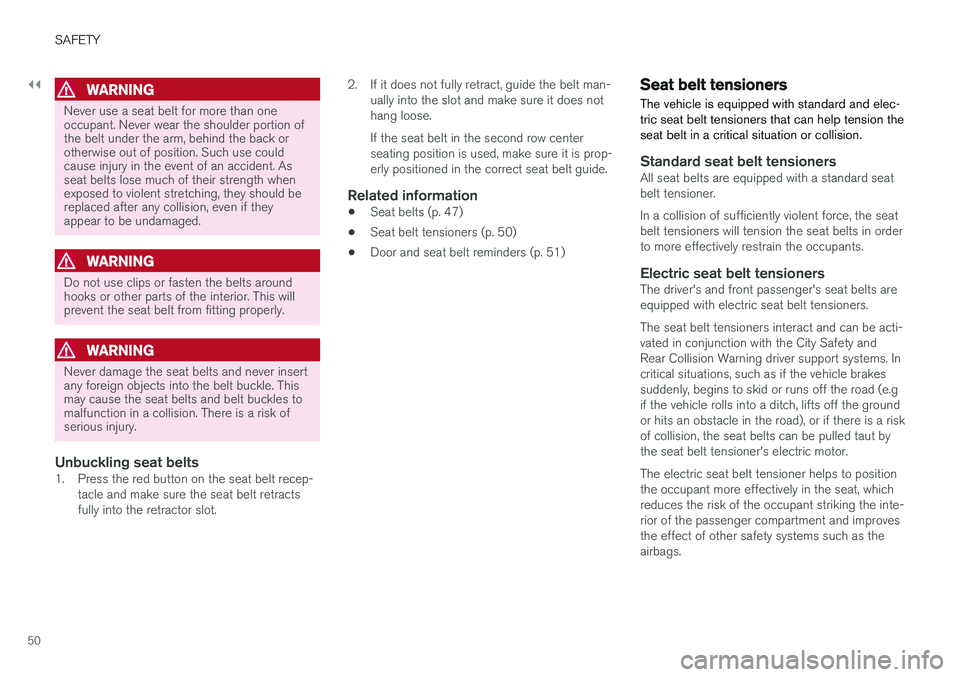
||
SAFETY
50
WARNING
Never use a seat belt for more than one occupant. Never wear the shoulder portion ofthe belt under the arm, behind the back orotherwise out of position. Such use couldcause injury in the event of an accident. Asseat belts lose much of their strength whenexposed to violent stretching, they should bereplaced after any collision, even if theyappear to be undamaged.
WARNING
Do not use clips or fasten the belts around hooks or other parts of the interior. This willprevent the seat belt from fitting properly.
WARNING
Never damage the seat belts and never insert any foreign objects into the belt buckle. Thismay cause the seat belts and belt buckles tomalfunction in a collision. There is a risk ofserious injury.
Unbuckling seat belts1. Press the red button on the seat belt recep-tacle and make sure the seat belt retracts fully into the retractor slot. 2. If it does not fully retract, guide the belt man-
ually into the slot and make sure it does nothang loose. If the seat belt in the second row center seating position is used, make sure it is prop-erly positioned in the correct seat belt guide.
Related information
• Seat belts (p. 47)
• Seat belt tensioners (p. 50)
• Door and seat belt reminders (p. 51)
Seat belt tensioners
The vehicle is equipped with standard and elec- tric seat belt tensioners that can help tension theseat belt in a critical situation or collision.
Standard seat belt tensionersAll seat belts are equipped with a standard seat belt tensioner. In a collision of sufficiently violent force, the seat belt tensioners will tension the seat belts in orderto more effectively restrain the occupants.
Electric seat belt tensionersThe driver's and front passenger's seat belts areequipped with electric seat belt tensioners. The seat belt tensioners interact and can be acti- vated in conjunction with the City Safety andRear Collision Warning driver support systems. Incritical situations, such as if the vehicle brakessuddenly, begins to skid or runs off the road (e.gif the vehicle rolls into a ditch, lifts off the groundor hits an obstacle in the road), or if there is a riskof collision, the seat belts can be pulled taut bythe seat belt tensioner's electric motor. The electric seat belt tensioner helps to position the occupant more effectively in the seat, whichreduces the risk of the occupant striking the inte-rior of the passenger compartment and improvesthe effect of other safety systems such as theairbags.
Page 84 of 666
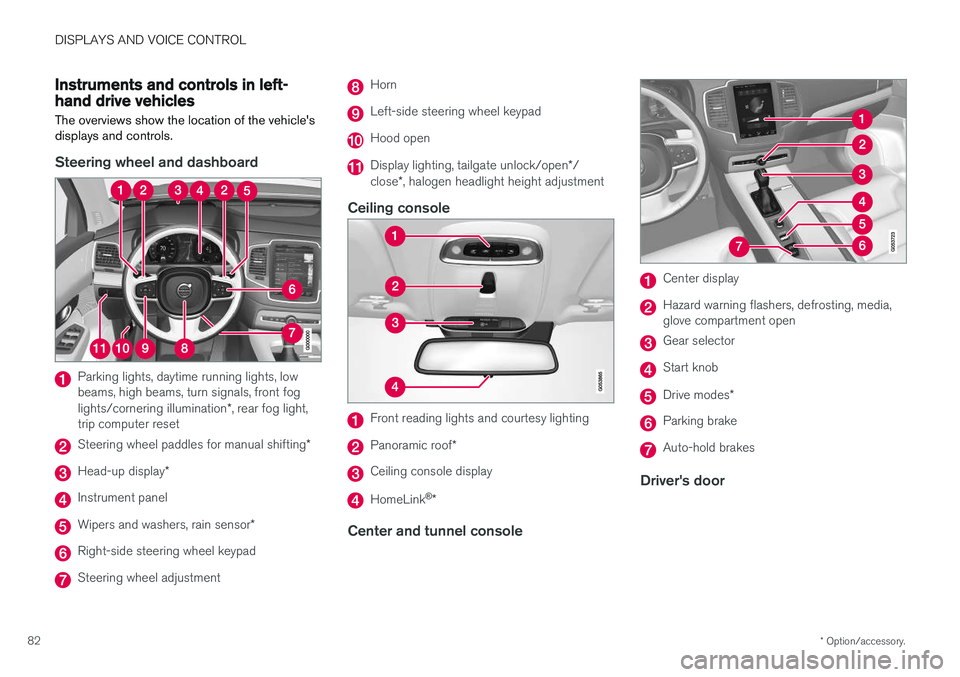
DISPLAYS AND VOICE CONTROL
* Option/accessory.
82
Instruments and controls in left-hand drive vehicles
The overviews show the location of the vehicle's
displays and controls.
Steering wheel and dashboard
Parking lights, daytime running lights, low beams, high beams, turn signals, front fog lights/cornering illumination *, rear fog light,
trip computer reset
Steering wheel paddles for manual shifting *
Head-up display*
Instrument panel
Wipers and washers, rain sensor *
Right-side steering wheel keypad
Steering wheel adjustment
Horn
Left-side steering wheel keypad
Hood open
Display lighting, tailgate unlock/open */
close *, halogen headlight height adjustment
Ceiling console
Front reading lights and courtesy lighting
Panoramic roof *
Ceiling console display
HomeLink®
*
Center and tunnel console
Center display
Hazard warning flashers, defrosting, media, glove compartment open
Gear selector
Start knob
Drive modes *
Parking brake
Auto-hold brakes
Driver's door
Page 86 of 666

DISPLAYS AND VOICE CONTROL
* Option/accessory.
84
Instrument panel
The instrument panel displays information rela- ted to the vehicle and driving.
The instrument panel contains gauges, indicators and monitoring and warning symbols. What isshown in the instrument panel varies dependingon the equipment, settings and functions cur-rently active. The instrument panel is activated as soon as a door is opened, i.e. in ignition mode 0. The panel
will power down after a short period of time if it is not used. To reactivate it, do one of the following:
• Depress the brake pedal.
• Activate ignition mode
I.
• Open one of the doors. The instrument panel is available in two versions: 12"
* and 8".WARNING
If the instrument panel is not functioning properly, information about brakes, airbags orother safety-related systems may not be dis-played. The driver will then not be able tocheck the status of the vehicle systems orreceive relevant warnings and information.
WARNING
If the instrument panel turns off, does not activate when the ignition is switched on, orpart/all of the panel cannot be read, do notdrive the vehicle. Consult a workshop immedi-ately. Volvo recommends an authorized Volvoworkshop.
Instrument panel 12" *
Location in the instrument panel:
Left sideIn the centerRight side
Speedometer Indicator and warning symbols Tachometer/ECO gaugeA
Trip odometer Ambient temperature sensor Gear indicator Odometer B
Clock Drive Mode
Cruise control/speed limiter information Message (also graphics in some cases) Fuel gauge
Road sign information * Door and seat belt status Start/Stop function's status
– Media player Distance to empty tank
Page 97 of 666
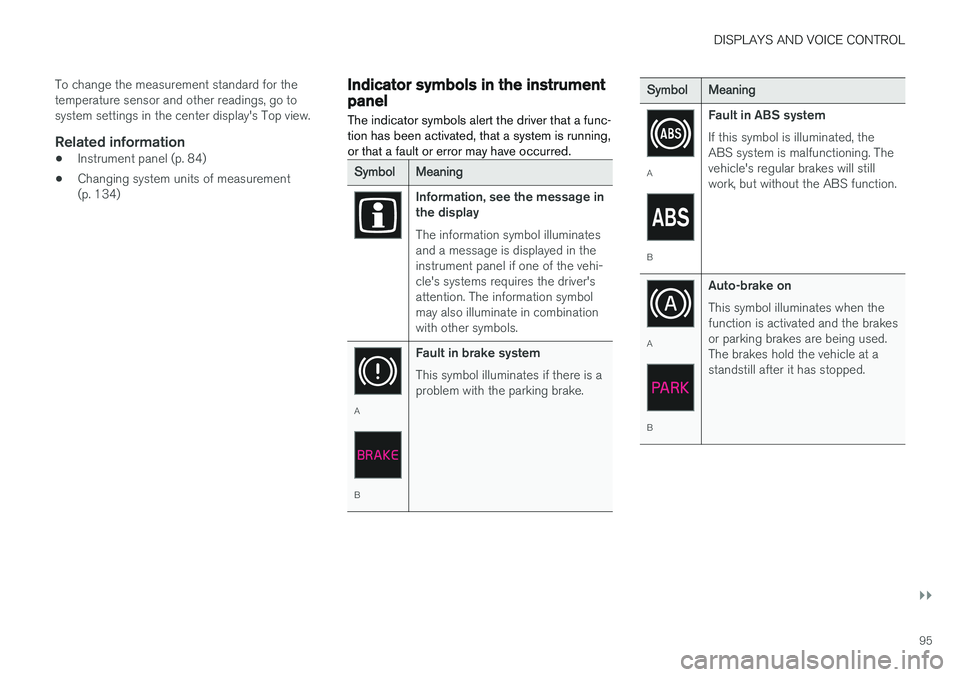
DISPLAYS AND VOICE CONTROL
}}
95
To change the measurement standard for the temperature sensor and other readings, go tosystem settings in the center display's Top view.
Related information
•
Instrument panel (p. 84)
• Changing system units of measurement(p. 134)
Indicator symbols in the instrumentpanel
The indicator symbols alert the driver that a func- tion has been activated, that a system is running,or that a fault or error may have occurred.
SymbolMeaning
Information, see the message in the display The information symbol illuminates and a message is displayed in theinstrument panel if one of the vehi-cle's systems requires the driver'sattention. The information symbolmay also illuminate in combinationwith other symbols.
A
B Fault in brake system This symbol illuminates if there is a problem with the parking brake.
SymbolMeaning
A
BFault in ABS system If this symbol is illuminated, the ABS system is malfunctioning. Thevehicle's regular brakes will stillwork, but without the ABS function.
A
BAuto-brake on This symbol illuminates when the function is activated and the brakesor parking brakes are being used.The brakes hold the vehicle at astandstill after it has stopped.
Page 165 of 666
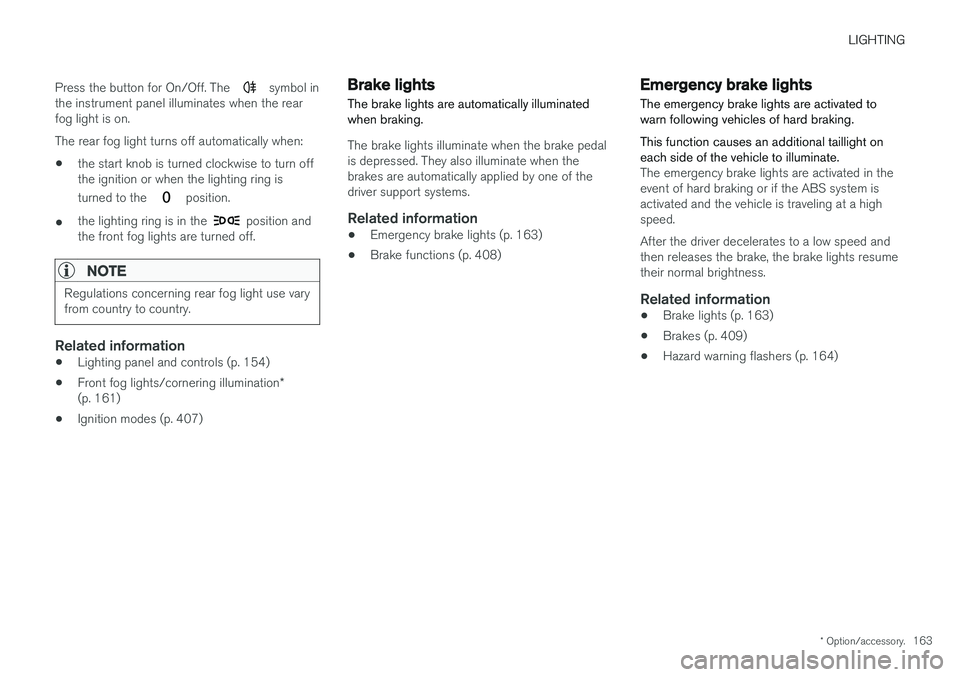
LIGHTING
* Option/accessory.163
Press the button for On/Off. The
symbol in
the instrument panel illuminates when the rear fog light is on. The rear fog light turns off automatically when:
• the start knob is turned clockwise to turn off the ignition or when the lighting ring is turned to the
position.
• the lighting ring is in the
position and
the front fog lights are turned off.
NOTE
Regulations concerning rear fog light use vary from country to country.
Related information
• Lighting panel and controls (p. 154)
• Front fog lights/cornering illumination
*
(p. 161)
• Ignition modes (p. 407)
Brake lights The brake lights are automatically illuminated when braking.
The brake lights illuminate when the brake pedal is depressed. They also illuminate when thebrakes are automatically applied by one of thedriver support systems.
Related information
• Emergency brake lights (p. 163)
• Brake functions (p. 408)
Emergency brake lights
The emergency brake lights are activated to warn following vehicles of hard braking. This function causes an additional taillight on each side of the vehicle to illuminate.
The emergency brake lights are activated in the event of hard braking or if the ABS system isactivated and the vehicle is traveling at a highspeed. After the driver decelerates to a low speed and then releases the brake, the brake lights resumetheir normal brightness.
Related information
• Brake lights (p. 163)
• Brakes (p. 409)
• Hazard warning flashers (p. 164)
Page 272 of 666

DRIVER SUPPORT
* Option/accessory.
270
Driver support systems
The vehicle is equipped with a number of driver support systems that can provide the driver withactive or passive assistance in various situations.
The system can, for example, help the driver maintain a set speed or a set time interval to thevehicle ahead, help prevent a collision by warningthe driver and applying the brakes, or assist thedriver while parking. Some of the systems are standard and others are options. This also varies from market to market.
Related information
• Speed-dependent steering wheel resistance(p. 270)
• Electronic Stability Control (p. 272)
• Stability system Roll Stability Control(p. 271)
• Rear Collision Warning (p. 345)
• Speed limiter (p. 276)
• Cruise control (p. 284)
• Distance Alert
* (p. 289)
• Adaptive Cruise Control
* (p. 293)
• Pilot Assist (p. 309)
• Radar sensor (p. 324)
• Camera (p. 329)
• City Safety
™ (p. 333)
• BLIS
* (p. 346) •
Cross Traffic Alert
* (p. 351)
• Road Sign Information
* (p. 355)
• Driver Alert Control (p. 360)
• Lane Keeping Aid (p. 362)
• Steering assistance at risk of collision(p. 370)
• Park Assist
* (p. 379)
• Park Assist Camera
* (p. 384)
• Park Assist Pilot
* (p. 393)
Speed-dependent steering wheelresistance
Speed-dependent power steering increases the steering wheel resistance in pace with the vehi-cle's speed to give the driver an enhanced feel-ing of control and stability.
Steering may feel stiffer on highways. When parking and at low speeds, it will be easier tomove the steering wheel.
NOTE
In some situations, the power steering may become too hot and require temporary cool-ing – during such time the power steering willwork at reduced output and the steeringwheel may feel more difficult to move. In parallel with the temporarily reduced steer- ing assistance, the driver display shows amessage as well as a STEERING WHEELsymbol.
Page 273 of 666

DRIVER SUPPORT
* Option/accessory.271
WARNING
While the power steering is working at reduced power, the driver support functionswith steering assistance are not available. In such a situation, the driver display shows the
Power steering failure or Power
Steering Assist Temporarily Reduced
message, combined with a STEERING WHEEL symbol.
Changing the level of steering wheel resistance *
To change the level of steering wheel resistance, see the description of the INDIVIDUAL optionunder "Available drive modes" in the "Drivemodes" section. On models not equipped with drive mode con- trols and the INDIVIDUAL option, steering wheelresistance can instead be set in the center dis-play's Top view under:
SettingsMy CarDrive ModesSteering force
Steering wheel resistance settings cannot be accessed when turning at speeds above10 km/h (6 mph).
Related information
•Drive modes
* (p. 423)
• Pilot Assist (p. 309) •
Lane Keeping Aid (p. 362)
• Steering assistance at risk of collision(p. 370)
• Park Assist Pilot
* (p. 393)
Stability system Roll StabilityControl
The Roll Stability Control (RSC 1
) system helps
minimize the risk of a rollover in the event of e.g. a sudden evasive maneuver or if the vehiclebegins to skid.
The RSC system monitors the lateral angle at which the vehicle is leaning and registers anychanges. Using this information, the system cal-culates the likelihood of a rollover. If there is animminent risk of a rollover, Electronic StabilityControl is activated, engine torque is reduced andbrakes are applied to one or more of the wheelsuntil the vehicle has regained stability.
WARNING
The vehicle
Page 274 of 666
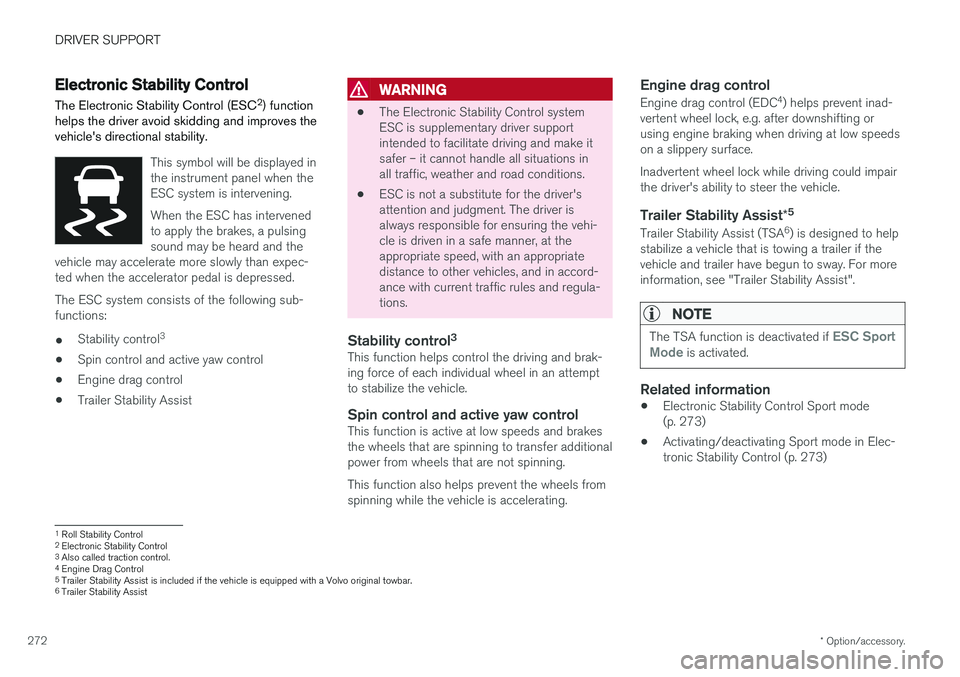
DRIVER SUPPORT
* Option/accessory.
272
Electronic Stability Control
The Electronic Stability Control (ESC 2
) function
helps the driver avoid skidding and improves the vehicle's directional stability.
This symbol will be displayed in the instrument panel when theESC system is intervening. When the ESC has intervened to apply the brakes, a pulsingsound may be heard and the
vehicle may accelerate more slowly than expec-ted when the accelerator pedal is depressed.
The ESC system consists of the following sub- functions: • Stability control 3
• Spin control and active yaw control
• Engine drag control
• Trailer Stability Assist
WARNING
•The Electronic Stability Control system ESC is supplementary driver supportintended to facilitate driving and make itsafer – it cannot handle all situations inall traffic, weather and road conditions.
• ESC is not a substitute for the driver'sattention and judgment. The driver isalways responsible for ensuring the vehi-cle is driven in a safe manner, at theappropriate speed, with an appropriatedistance to other vehicles, and in accord-ance with current traffic rules and regula-tions.
Stability control 3This function helps control the driving and brak-ing force of each individual wheel in an attemptto stabilize the vehicle.
Spin control and active yaw controlThis function is active at low speeds and brakesthe wheels that are spinning to transfer additionalpower from wheels that are not spinning. This function also helps prevent the wheels from spinning while the vehicle is accelerating.
Engine drag control
Engine drag control (EDC
4
) helps prevent inad-
vertent wheel lock, e.g. after downshifting orusing engine braking when driving at low speedson a slippery surface. Inadvertent wheel lock while driving could impair the driver's ability to steer the vehicle.
Trailer Stability Assist *5
Trailer Stability Assist (TSA
6
) is designed to help
stabilize a vehicle that is towing a trailer if thevehicle and trailer have begun to sway. For moreinformation, see "Trailer Stability Assist".
NOTE
The TSA function is deactivated if ESC Sport
Mode is activated.
Related information
• Electronic Stability Control Sport mode (p. 273)
• Activating/deactivating Sport mode in Elec-tronic Stability Control (p. 273)
1
Roll Stability Control
2 Electronic Stability Control
3 Also called traction control.
4 Engine Drag Control
5Trailer Stability Assist is included if the vehicle is equipped with a Volvo original towbar.6
Trailer Stability Assist